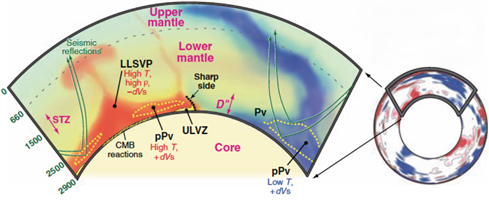Giant oxygen reservoirs near the Earth’s core – Seek and find - Dr. Ho-Kwang Mao
NOVEMBER 23, 2017
Free oxygen in the air that gives life to our living planet cannot be taken for granted. In fact, during the first half of the Earth’s 4.6 billion year history, oxygen was absent in the atmosphere. Only 2.4 billion years ago at the Great Oxidation Event (GOE), oxygen appeared suddenly, thus enabling the aerobic life like us to thrive and evolve. In seeking for possible source of the oxygen rise, superoxidized iron from great depth is a potential candidate. Through direct experiments and theoretical calculations that mimic deep Earth environments, a group of scientists led Ho-kwang Mao, director of HPSTAR (the Center of High Pressure Science and Technology Advanced Research, China) found that the physical properties of iron peroxide match the seismic signatures of an enigmatic region, called ultralow velocity zone (ULVZ) at the boundary between the Earth’s lower mantle and core 1800 miles beneath the surface, thus supporting ULVZ as a possible deep reservoir of oxygen. The findings are reported in the November 23 issue of Nature.
Although oxygen is the most abundant element in the Earth, it bonds to other elements to form oxides, and does not yield free oxygen unless under highly oxidized condition. This is especially true in the Earth’s deep interior when we approach the metallic core which is highly reducing, i.e., lack of oxygen. Therefore, during the late 20th century when ancient geological records firmly established the concept of sudden oxygen rise at GOE, an internal source of oxygen was not considered. Instead, the dominant theory assumed oxygen generation exclusively from cyanobacteria photosynthesis of surface carbon dioxide. Last year, a new pressure-induced chemical reaction to form superoxidized iron peroxide (FeO2) was discovered (Hu, et al., Nature 2016). Further studies (Hu, et al., PNAS, 2017, Zhu, et al., JACS, 2017) indicated that this peroxide could be synthesized by reacting water with the iron at the Earth’s core-mantle boundary (CMB) conditions. Considering the massive amount of water continuously carried down (Hwang et al., Nature Geosci. 2017) by subducting oceanic plate to meet the gigantic iron core, their reaction must form a giant oxygen reservoir that we ought to be able to find (Mao, et al., NSR, 2017).
Earthquakes send seismic waves travelling through all regions of the Earth’s deep interior to be recorded by the global network stations. They contain a wealth of information about the materials properties on their paths, and provide a clear visual image of these regions, analogous to the use of ultrasound to visualize the details and anomalies of human internal organs. Seismology has actually observed an abnormal region in the CMB region, called ULVZ, with 10% lower compressional-wave velocity and 30% lower shear-wave velocities than the average lower mantle.
Drs. Qingyang Hu of HPSTAR and Jing Liu from Standford University and co-workers conducted high pressure-temperature experiment using a diamond-anvil cell to study the corresponding wave velocities of the iron peroxide. Employing the high-energy synchrotron x-radiation and state-of-the art diffraction and spectroscopy probes at the High Pressure Collaborative Access Team facility at the Advanced Photon Source, Argonne National Laboratory, they found compressional and shear wave velocities of iron peroxide to be very low. A mixture of normal mantle rock with 40-50% iron peroxide would be sufficient to match the seismic signature of the ULVZ.
“Finding the existence of a giant internal oxygen reservoir has many far-reaching implications,” said Mao. “Now we should reconsider the consequences of sporadic oxygen outbursts and their correlations to other major events in the Earth’s history, such as the banded-iron formation, snowball Earth, mass extinctions, flood basalts, and supercontinent riftings.”
Other team members including Jin Liu and Wendy L. Mao of Stanford University, Qingyang Hu and Duckyoung Kim of the Center of High Pressure Science and Technology Advanced Research, China, Zhongqing Wu and Wenzhong Wang of University of Science and Technol ogy of China, Yuming Xiao, Paul Chow, and Yue Meng of High Pressure Collaborative Access Team, and Vitali B. Prakapenka of Center for Advanced Radiation Sources.
ogy of China, Yuming Xiao, Paul Chow, and Yue Meng of High Pressure Collaborative Access Team, and Vitali B. Prakapenka of Center for Advanced Radiation Sources.
Caption: The movement of seismic waves through the material of the mantle allows scientists to image Earth’s interior, just as a medical ultrasound allows technicians to look inside a blood vessel. Image is courtesy of Edward Garnero and Allen McNamara’s 2008 Science paper Structure and Dynamics of Earth’s Lower Mantle, provided with Garnero’s permission.
媒体报道:
Carnegie Science: https://carnegiescience.edu/news/mysterious-deep-earth-seismic-signature-explained
ScienceDaily: https://www.sciencedaily.com/releases/2017/11/171122131429.htm
Phys. ORG: https://phys.org/news/2017-11-mysterious-deep-earth-seismic-signature.html
我们的生命倚赖于空气中的氧,但是空气中不是一开始就有氧的。地质学家们发现,在地球漫长的46亿年中,前一半古老历史的大气里并不含氧。直到24亿年前,地球发生了“大氧化事件”,空气中的自由氧突然飙升到百分之二十,维持至今,才会有人类的存在。北京高压科学研究中心(高科)主任毛河光院士带领国际科研团队,一年来系统化探索大氧化事件的根源,锁定在了高压下才存在的铁的新氧化物¾过氧化铁。该团队最新的研究更发现过氧化铁确实与核幔交界处超低速区的地震波速度符合。说明该区域可能有大量过氧化铁存在。当其所含氧爆发时,即能产生大氧化事件。此成果刊登在11月23日的《自然》期刊上(Liu及合作者,Nature,2017).
